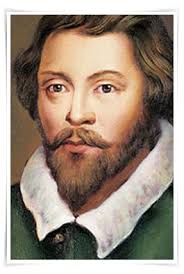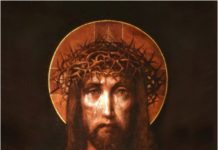Few composers have lived and nonetheless thrived in such a turbulent era as William Byrd. Born sometime between 1539 and 1543, Byrd grew up in newly Protestant England, Henry VIII having passed the Act of Supremacy in 1534, which completed the separation of the English Church (later becoming known as Anglicanism) from the Roman Catholic Church. By the time Byrd died in 1623, there had been five reigning monarchs. Of these, only one—Mary I—was Catholic, and in Byrd’s lifetime hundreds, perhaps even thousands, of Catholics were martyred for their faith.
Roughly 300 of these martyrs are remembered by name in the Catholic Church, of whom Byrd knew some personally. St. Robert Southwell – priest, poet and martyr – after his training and ordination on the continent, spent some of his first time back in England at Hurleyford House, where his is recorded as having met William Byrd.[i] The composer was certainly familiar with the Jesuit martyrs. Byrd set the poem, “Why Do I Use My Paper, Ink, and Pen?” to music in his collection of 1588, titled Psalmes, Sonets, and Songs. This is no ordinary poem, however, for it was most likely written by St. Henry Walpole, who converted to Catholicism after witnessing the martyrdom of St. Edmund Campion. Walpole quickly left England to become a Jesuit, and only days after returning as a priest, he was captured, and himself martyred in 1595, some fourteen years after Campion.[ii]
While it is not clear if Byrd was raised a Catholic, in the 1580s, he and his wife began to appear on the list of recusants (from Latin recusare, “to refuse”), that is, people who did not attend the mandatory services of the Church of England.[iii] It remains an astonishing balancing act that Byrd was able to continue as a faithful Catholic during the this period in which he worked in the Chapel Royal of Queen Elizabeth I, while priests, monks and the laity alike were killed for their faith. It is during this decade, one that first saw St. Edmund Campion martyred (d. 1581), and the execution of Mary Queen of Scots, that Byrd began to focus more heavily on the composition of Latin motets. This is one of the oldest genres of sacred music, having a secondary place only to Gregorian chant. Many of Byrd’s motets from this period set texts from the penitential psalms, using the different captivities of the Israelites as an allegory for the suffering of English Catholics.
Word painting is a technique in which the composer uses different elements of music to evoke the imagery exhibited in the text of the work. Vigilate, from an 1589 publication of motets, has numerous examples of word painting. Byrd sets, in Latin, Christ’s words from Mark 13: 35-37: “Watch ye therefore, (for you know not when the lord of the house cometh: at even, or at midnight, or at the cockcrowing, or in the morning,) Lest coming on a sudden, he find you sleeping. And what I say to you, I say to all: Watch.” (Douay-Rheims) Unlike many of Byrd’s more serene motets, this work is at times frenetic. The opening section, with its incessant repetition of “vigilate,” is the composer calling out to his fellow Englishmen to be vigilant, to be watchful, for the Lord could return in His Second Coming at any time. This watchful atmosphere continues, until it is interrupted by the basses with the almost triumphant phrase, “an gallicantu,” referring to the cock crowing, which could signal the coming of Christ. The piece continues to become more intense, approaching the height of the work’s tension on the word, “repente,” meaning “suddenly.” Byrd cleverly composes a tight layering effect in three voices, in which the voices nearly trip over each other in this passage, in an effort to convey the urgency in which England must return to Catholicism. Byrd then repeats a previous section of text, “ne cum venerit,” (“lest coming”), in the midst of a frenzied singing of “repente.” This dizzying array of contrapuntal skill contributes to a feeling of imperativeness. The motet ends with another iteration of “vigilate,” calling once again for his countrymen to be watchful for the coming of the Lord. Byrd possibly—perhaps even likely—believed that Christ would return within his lifetime, or at least soon, to restore the Catholic Church in England. Vigilate illustrates the composer’s own faith while calling those around him to return to Catholicism.
While not as elaborate as Vigilate, another motet that exhibits word painting is the more well-known Ave Verum Corpus. It comes from the 1605 Gradualia, in which Byrd aimed to write motets based on all of the Propers of the Mass. This motet is for the Feast of Corpus Christi. In the first phrase, setting a 14th century text. Byrd uses a false relation several times in this piece. Also known as a cross relation, this unique kind of dissonance was a favourite of the English Renaissance composers long after its use had died out on this continent. In its simplest form, a false relation involves two notes, a semitone a part (the distance between a white key and the adjacent black key on a piano), but having the same letter name. Between the words “ave” (“hail”) and “verum” (“true”), Byrd has the F-sharp of the first chord in the second measure (a D-major triad in the context of the G minor modality) become an F-natural (of an F-major triad) in the second chord of the second measure. This occurs on the first syllable of verum, which draws attention to “true” in “hail true body,” highlighting the Catholic belief of the Real Presence of Christ in the Eucharist. Later in the work, Byrd uses a more striking false relation. On the word miserere (“have mercy”), the composer has the tenors and basses rub against each other, with the pitches of F-sharp and F-natural, which emphasizes our need for the Lord’s mercy. Byrd uses this dissonant device several times on miserere, depicting in the music the suffering of Christ’s body, asking for God to have mercy on us.
William Byrd’s masterful motets, written in a time of religious turmoil and political upheaval, stand as timeless examples of sacred choral music. Unlike so many of his friends and fellow Catholics, Byrd died comfortably at home in his early eighties. In 1622, he wrote a prayer in his will, “that I may live and die a true and perfect member” of the “holy Catholic Church, without which I believe there is no salvation for me.”[iv] Byrd’s motets are imbued with his deep faith, and a sense of reaching toward the transcendent heights of God Himself.
Endnotes
[i] Mann, Stephanie A. “The Fascinating Mr. Byrd.” Catholic Exchange, April 10, 2012. https://catholicexchange.com/the-fascinating-mr-byrd.
[ii] Mann, Stephanie A. “The Blood of One Martyr Inspires Another.” National Catholic Register, December 9, 2016. https://www.ncregister.com/blog/stephaniemann/the-blood-of-one-martyr-inspires-another.
[iii] Trendell, David. “Aspects of William Byrd’s Musical Recusancy.” The Musical Times 148, no. 1900 (2007): 27-50. Accessed May 10, 2020. doi:10.2307/25434476.
[iv] Sullivan, Roseanne T. “William Byrd’s Secret Catholic Masterpieces.” Catholic Education Resource Center, November 19, 2013. https://www.catholiceducation.org/en/culture/music/william-byrd-s-secret-catholic-masterpieces.html.












